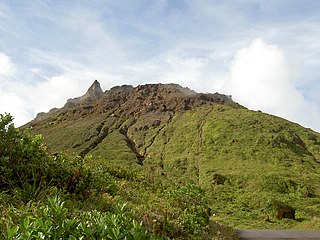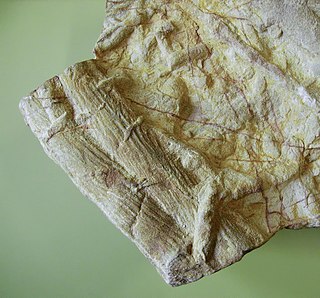
Agnostida are an order of extinct arthropods which have classically been seen as a group of highly modified trilobites, though some recent research has doubted this placement. Regardless, they appear to be close relatives as part of the Artiopoda. They are present in the Lower Cambrian fossil record along with trilobites from the Redlichiida, Corynexochida, and Ptychopariida orders, and were highly diverse throughout the Cambrian. Agnostidan diversity severely declined during the Cambrian-Ordovician transition, and the last agnostidans went extinct in the Late Ordovician.

Trilobites are extinct marine arthropods that form the class Trilobita. Trilobites form one of the earliest known groups of arthropods. The first appearance of trilobites in the fossil record defines the base of the Atdabanian stage of the Early Cambrian period and they flourished throughout the lower Paleozoic before slipping into a long decline, when, during the Devonian, all trilobite orders except the Proetida died out. The last trilobites disappeared in the mass extinction at the end of the Permian about 251.9 million years ago. Trilobites were among the most successful of all early animals, existing in oceans for almost 270 million years, with over 22,000 species having been described.

Redlichiida is an order of trilobites, a group of extinct marine arthropods. Species assigned to the order Redlichiida are among the first trilobites to appear in the fossil record, about halfway during the Lower Cambrian. Due to the difficulty to relate sediments in different areas, there remains some discussion, but among the earliest are Fallotaspis, and Lemdadella, both belonging to this order. The first representatives of the orders Corynexochida and Ptychopariida also appear very early on and may prove to be even earlier than any redlichiid species. In terms of anatomical comparison, the earliest redlichiid species are probably ancestral to all other trilobite orders and share many primitive characters. The last redlichiid trilobites died out before the end of the Middle Cambrian.

Java Man is an early human fossil discovered in 1891 and 1892 on the island of Java (Indonesia). Estimated to be between 700,000 and 1,490,000 years old, it was, at the time of its discovery, the oldest hominid fossil ever found, and it remains the type specimen for Homo erectus.

La Grande Soufrière, or simply Soufrière, is an active stratovolcano on the French island of Basse-Terre, Guadeloupe. It is the highest mountain peak in the Lesser Antilles, rising 1,467 m (4,813 ft) high.

Phacopida ("lens-face") is an order of trilobites that lived from the Late Cambrian to the Late Devonian. It is made up of a morphologically diverse assemblage of taxa in three related suborders.
The Lopingian is the uppermost series/last epoch of the Permian. It is the last epoch of the Paleozoic. The Lopingian was preceded by the Guadalupian and followed by the Early Triassic.
A pantropical distribution is one which covers tropical regions of both hemispheres. Examples of species include caecilians, modern sirenians and the plant genera Acacia and Bacopa.

In anatomy, a suture is a fairly rigid joint between two or more hard elements of an organism, with or without significant overlap of the elements.

Cruziana is a trace fossil consisting of elongate, bilobed, approximately bilaterally symmetrical burrows, usually preserved along bedding planes, with a sculpture of repeated striations that are mostly oblique to the long dimension. It is found in marine and freshwater sediments. It first appears in upper Fortunian rocks of northern Iran and northern Norway. Cruziana has been extensively studied because it has uses in biostratigraphy, and because the traces can reveal many aspects of their makers' behavior.

Charles Emerson Beecher was an American paleontologist most famous for the thorough excavation, preparation and study of trilobite ventral anatomy from specimens collected at Beecher's Trilobite Bed. Beecher was rapidly promoted at Yale Peabody Museum, eventually rising to head that institution.

The 1880 earthquake which struck Zagreb, and is also known as The Great Zagreb earthquake, occurred with a moment magnitude of 6.3 on 9 November 1880. Its epicenter was in the Medvednica mountain north of Zagreb. Although only one person was killed in the earthquake, it destroyed or damaged many buildings.

Eoredlichia is an extinct genus of trilobite of average to large size. It lived during the early Cambrian in the Chengjiang fauna of Yunnan, China, and in Australia and Thailand. Eoredlichia is compounded of the Greek ἠώς and Redlichia, a later but related genus, so it means "early Redlichia". The species epithet intermedia means intermediate, indicating it is morphologically intermediate between other species. Eofallotaspis gives rise to Lemdadella, and thence to Eoredlichia and the other Redlichiidae.

Phillipsiidae is a family of proetid trilobites, the various genera of which comprise some of the last of the trilobites, with a range that extended from the Kinderhookian epoch of the Lower Mississippian, to the end of Changhsingian age at Permian-Triassic extinction event in the latest Permian period.
A gerontoplast is a plastid that develops from a chloroplast during the senescing of plant foliage. Gerontoplast development is generally seen to be the process of grana being unstacked, loss of thylakoid membranes, and large accumulation of plastoglobuli.

Paleontology in Illinois refers to paleontological research occurring within or conducted by people from the U.S. state of Illinois. Scientists have found that Illinois was covered by a sea during the Paleozoic Era. Over time this sea was inhabited by animals including brachiopods, clams, corals, crinoids, sea snails, sponges, and trilobites.
Feminist metaphysics aims to question how inquiries and answers in the field of metaphysics have supported sexism. Feminist metaphysics overlaps with fields such as the philosophy of mind and philosophy of self. Feminist metaphysicians such as Sally Haslanger, Ásta, and Judith Butler have sought to explain the nature of gender in the interest of advancing feminist goals.

Cozido à portuguesa or Portuguese stew is a type of cozido, traditional Portuguese boiled meal. Numerous regional variations exist throughout Portugal, and the dish is considered part of the Portuguese heritage, as well as one of the national dishes of Portugal.

In geometry, a chair tiling is a nonperiodic substitution tiling created from L-tromino prototiles. These prototiles are examples of rep-tiles and so an iterative process of decomposing the L tiles into smaller copies and then rescaling them to their original size can be used to cover patches of the plane. Chair tilings do not possess translational symmetry, i.e., they are examples of nonperiodic tilings, but the chair tiles are not aperiodic tiles since they are not forced to tile nonperiodically by themselves. The trilobite and cross tiles are aperiodic tiles that enforce the chair tiling substitution structure and these tiles have been modified to a simple aperiodic set of tiles using matching rules enforcing the same structure. Barge et al. have computed the Čech cohomology of the chair tiling and it has been shown that chair tilings can also be obtained via a cut-and-project scheme.
Laetolia is an extinct genus of galagid primates from the Pliocene of Tanzania. It contains one species, L. sadimanensis, which is known from several dentary fragments discovered in the Upper Laetolil Beds of Laetoli. It was originally described in 1987 as a species of Galago, but a separate genus was erected for it in 2011.















